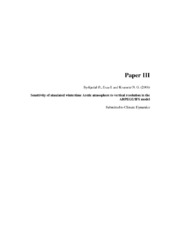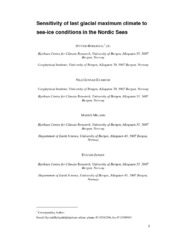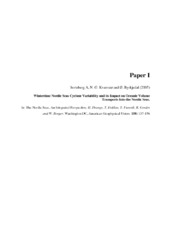| dc.contributor.author | Byrkjedal, Øyvind | eng |
| dc.date.accessioned | 2006-06-19T13:37:26Z | |
| dc.date.available | 2006-06-19T13:37:26Z | |
| dc.date.issued | 2006-06-08 | eng |
| dc.identifier.isbn | 82-308-0191-6 (print version) | en_US |
| dc.identifier.uri | https://hdl.handle.net/1956/1307 | |
| dc.description.abstract | The Arctic is a hot topic in Climate Research. A large number of signs of a warming Arctic Climate have been identified the latest years. This is of major concern in light of the increasing atmospheric content of greenhouse gases. The climate research community projects future warming of the climate in the high latitudes as a response to increased amounts of anthropogenic release of greenhouse gases since the pre-industrial era. The overall objectives of this work has been to study the mid- and high latitude climate and climate variability, and to evaluate how well some climate processes that contribute to determine the Arctic climate and variability are represented and simulated in climate models. A new data set of storm tracks trajectories and statistics over the Northern Hemisphere for the period 1948-2002 has been developed. The variability of the cyclones extending to the Nordic Seas is studied in particular, and it is found that both the number of storms and their intensity exhibits a strong decadal and interannual variability. The ocean volume transports into and out of the Nordic Seas shows a relatively close relation to the wintertime cyclone intensity and cyclone count. To have confidence in future projections of climate, it is necessary to evaluate how the model behaves in a climate regime different from modern day. To do this two model simulations of the last glacial maximum (LGM) was performed. The reconstructions of sea surface temperatures in the Nordic Seas in LGM differ from perennial sea ice cover to having open ocean during the summer. The large scale atmospheric circulation patterns of the two different climate reconstructions are studied. It is found that the perennial sea ice cover produces a circulation pattern which may be too zonal to support the existence of the large north Eurasian ice sheets. In the case with seasonally open ocean the air masses carries larger amounts of heat and moisture towards the ice sheets and represents a larger degree of meridional circulation. The current general circulation models, including several of those used by the IPCC, show considerable disagreement in simulating present day high latitude climate. This is of major concern and reduces the confidence in future model projections of high latitude climate. To investigate how turbulent vertical exchange processes in the Arctic boundary layer is represented by the climate models a simulation with high vertical resolution in the lower part of the atmosphere is performed. This reveals that the coarse vertical resolution commonly employed in the climate models are unable to reproduce important exchange processes in the Arctic boundary layer. In the case of our model this results in a warm bias over the Arctic Ocean. By increasing the vertical resolution we achieve a better representation of vertical turbulent exchange processes with the result of reproducing more realistic surface fluxes and surface air temperatures. | en_US |
| dc.format.extent | 1569431 bytes | eng |
| dc.format.extent | 12661770 bytes | eng |
| dc.format.extent | 2815222 bytes | eng |
| dc.format.extent | 895800 bytes | eng |
| dc.format.mimetype | application/pdf | eng |
| dc.format.mimetype | application/pdf | eng |
| dc.format.mimetype | application/pdf | eng |
| dc.format.mimetype | application/pdf | eng |
| dc.language.iso | eng | eng |
| dc.publisher | The University of Bergen | en_US |
| dc.relation.haspart | Paper 1: Sorteberg, A.; Kvamstø, N. G.; Byrkjedal, Ø., 2005, Wintertime Nordic Seas Cyclone Variability and its Impact on Oceanic Volume Transports Into the Nordic Seas, pp. 137-156. In: Drange, H.; Dokken, T.; Furevik, T.; Gerdes, R.; Berger, W., The Nordic Seas. An Integrated Perspective, Geophysical Monograph Series 158, 370 p. Copyright 2005 the American Geophysical Union. Reproduced with permission. Published version. | en_US |
| dc.relation.haspart | Paper 2: Climate Dynamics 26(5), Byrkjedal, Ø.; Kvamstø, N. G.; Meland, M.; Jansen, E., Sensitivity of last glacial maximum climate to sea-ice conditions in the Nordic Seas, pp. 473-487. Copyright 2006 Springer-Verlag. Reproduced with permission. Accepted version. Published version available at: <a href="http://dx.doi.org/10.1007/s00382-005-0096-2" target="blank">http://dx.doi.org/10.1007/s00382-005-0096-2</a> | en_US |
| dc.relation.haspart | Paper 3: Climate Dynamics 30(7-8), Byrkjedal, Ø.; Esau, I.; Kvamstø, N. G., Sensitivity of simulated wintertime Arctic atmosphere to vertical resolution in the ARPEGE/IFS model, pp. 687-701. Copyright 2007 Springer-Verlag. Reproduced with permission. Submitted version. Published version available at: <a href="http://dx.doi.org/10.1007/s00382-007-0316-z" target="blank">http://dx.doi.org/10.1007/s00382-007-0316-z</a> | en_US |
| dc.title | Aspects on interactions between mid- to high latitude atmospheric circulation and some surface processes | en_US |
| dc.type | Doctoral thesis | |
| dc.rights.holder | Copyright Øyvind Byrkjedal | en_US |
| dc.subject.nsi | VDP::Matematikk og Naturvitenskap: 400::Geofag: 450::Meteorologi: 453 | nob |



